
Desiring a compact ergonomic setup-- Everything within easy reach-- My small office is a very near-field monitoring environment. The main monitor speakers are about 1 meter distant from the listening position. Texas-sized Headphones!
I wanted deep bass with good dynamic range. Bass is not very directional, but I wanted to make the bass as directional as is possible, to maximize direct sound versus room reflections. For good time-alignment, the subwoofer should also be about 1 meter away from the listening position, so that the audio time-of-flight from the mains to the ears, will be equal to the audio time-of-flight from the subwoofer to the ears.
From previous experience in live pro-sound, large speaker drivers tend to have a narrower coverage angle than small speaker drivers. So I decided to build an 18” subwoofer, desiring subwoofer directivity as narrow as possible.
Admittedly, in theory bass directivity should be very poor even with 18 inch or 21 inch woofers. However, in practice I recall decades ago when I used box-type ported 18 inch enclosures live on stage at numerous nightclub gigs-- Perhaps in theory the speakers were rather non-directional, but in practice there were always small hotspots in the audience, a table or two staring right down the throat of the 18 inch speaker cabinets, where the speakers were much louder than average-- Tables where customers with sensitive ears were more likely to make volume complaints about those speakers. So perhaps it is not entirely ridiculous to hope to make a subwoofer “somewhat directional” in a small room.
Flat response down to 40 Hz is adequate for most purposes, but “just because” I wanted to make the system as flat possible down to 20 Hz. The goal is low distortion full-range sound, not ear-punishing loud volume levels.
After researching various drivers and speaker designs, it was surprising how difficult it is, to get flat response down to 20 Hz. This is a much more difficult task than achieving flat response down to 40 Hz. In small rooms, if one wants flat frequency response and good phase accuracy, sealed subwoofers are better than ported subwoofers. Ported speakers more easily make very loud sound pressure levels, with the trade-off that typical ported woofers can't properly reproduce very low frequencies, except when ported speaker cabinets are built extraordinarily huge.
For good low-frequency performance-- One would build fairly heavy in a sealed cabinet using high power amplification, merely to yield fairly conservative bass loudness levels down low. I initially expected that pro-sound drivers will be most ideal, but discovered that pro-sound 18” woofers are typically designed to work best in ported cabinets, high-passed at 40 Hz or higher.
I finally selected a “non-pro-sound” Dayton Audio UM18-22 18” woofer. In sealed cabinets, low bass response is primarily limited by Xmax, which is the distance which the cone can move without bottoming-out or excessive nonlinearity in cone motion. The Xmax of the UM18-22 is much larger than that of most pro-audio woofers. In addition, the UM18-22 speaker's electro-mechanical characteristics are friendlier to sealed cabinets than are most pro-audio woofers.
As far as I could find out, the Dayton Audio UM18-22 is fairly friendly to sealed cabinets from 2 to 8 cubic foot volume-- A speaker which is not especially picky about its enclosure volume.
The cabinet design specs-- A big speaker cabinet, with the speaker aimed right at my head from 1 meter distance. Ideally the cabinet would have different dimensions for height, width and depth. Cubical speaker cabinets tend to exaggerate acoustic problems.
An ordinary rectangular cabinet would not fit amongst the other nearby equipment, at a mere 1 meter distance. After sketching many possible designs, settled upon the illustrated design to fit the available space and aim straight for my head from point-blank 1 meter distance-- While also making a design simple enough for my mediocre woodworking skills.
The cabinet is 28 inches tall, 24 inches from front to back, and 22 inches wide. The speaker baffle board is vertically angled 45 degrees to aim at my head. Two slices are cut-out from the front corners, so that the cabinet can be scooted “as close as possible” in the right angle corner between my front keyboard stand and my right hand equipment rack. The speaker aims both 45 degrees horizontally from the right-front corner, and also aims 45 degrees vertically. I do not recall if I ever precisely calculated the cabinet volume, but considering the odd shape and the internal bracing, the cabinet volume should be in the ballpark of 5 or 6 cubic feet.

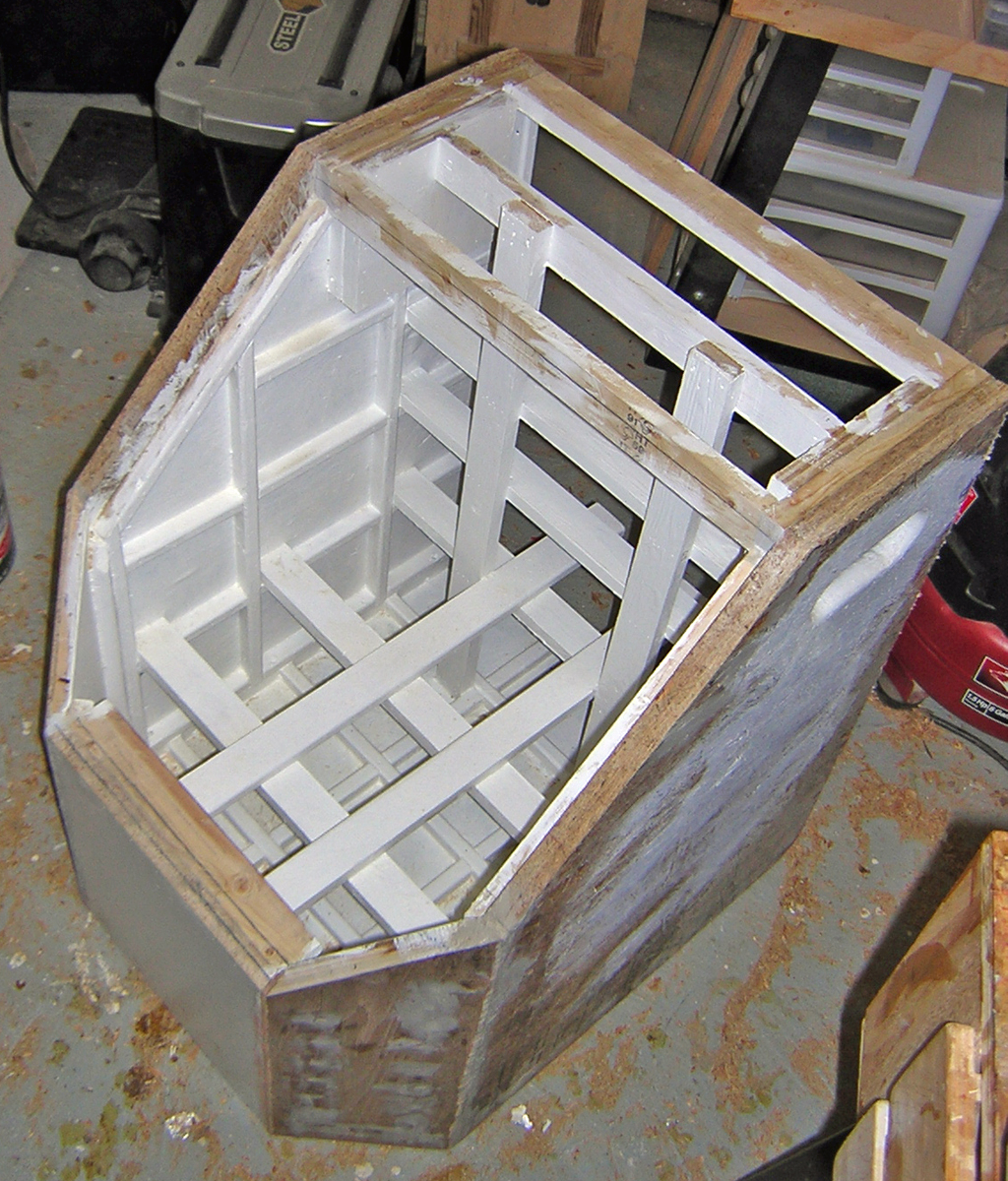
For best performance, subwoofers should have very rigid, non resonant enclosures. Some subwoofers are built much more rigid than mine, but I guestimated that maybe this would be “rigid enough” for modest sound pressure levels. It is built heavier-duty than any PA speakers I built in the past anyway.
The top, bottom, front, back and sides are half-inch plywood doubled-up to a thickness of “nearly 1 inch”. The sheets are doubled using Titebond III glue and numerous 18 gauge nailgun nails. Additionally, all panels are reinforced with a 6 inch spaced waffle-grid of three-quarter inch square pine struts, attached with nailgun and glue. There is 1 X 2 inch pine cross-bracing from side-to-side, top-to-bottom, and front-to-back.
The speaker baffle board is 1.75 inches thick, consisting of two lower half-inch layers of plywood, and one upper three-quarter-inch layer of plywood. The baffle board layers were cut to “interlock” with the cabinet-- The two lower half-inch layers cut to sit flush recessed inside the side panels, screwed and glued to those internal pine rails, and the top three-quarter inch plywood layer cut bigger to overlap the top edges of the opening, screwed and glued onto the top edge.
All panels except the baffle board were fitted together with titebond III and screws. My best job of layout and cutting was not quite good enough for the baffle board fit. It fit pretty tight with all the odd angles, but in my estimation not tight enough for mere titebond III. So I attached the baffle board using screws and lots of high strength, slow-cure epoxy glue to tightly fill the inexpertly cut baffleboard edge gaps.
The splotchy exterior in photos of the unfinished cabinet, is bondo and primer to fill screw holes and minor defects.
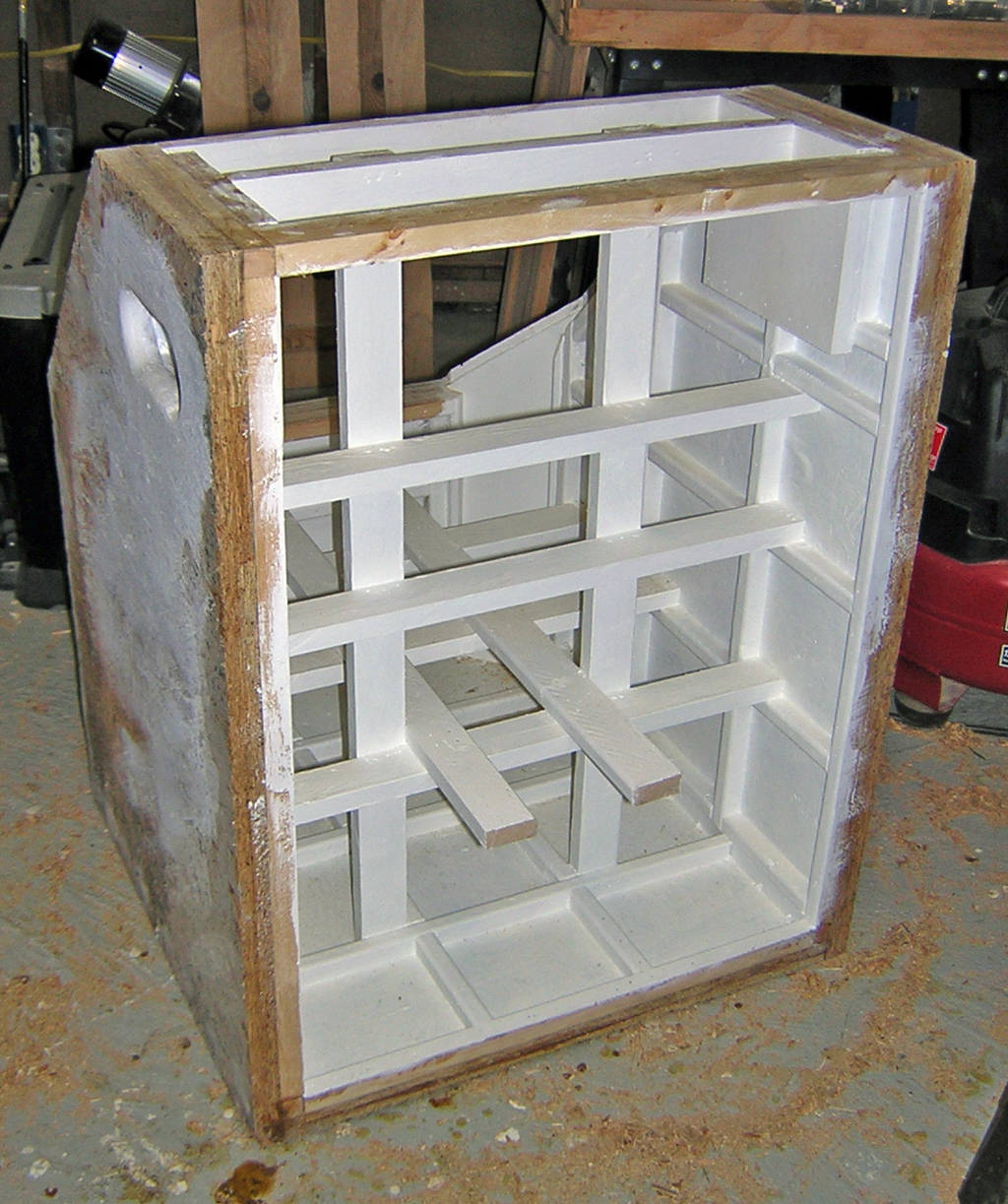
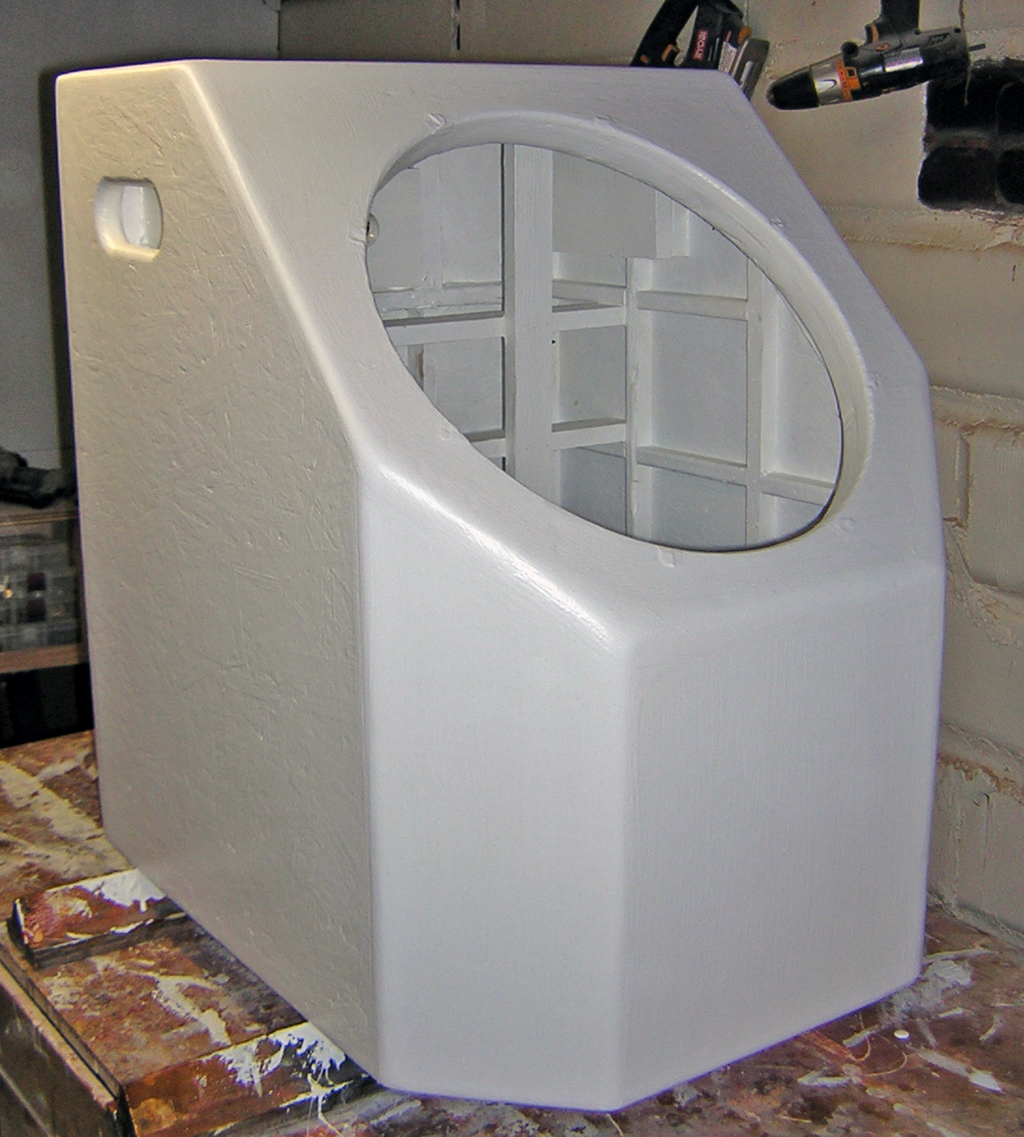
Rather than buy factory made handles and rear recessed jack panel, I “built-in” sealed handles and a recessed jack panel. Cut and routed the outside openings to size, then surrounded the inside of the openings with shallow air-sealed boxes made of three-quarter inch pine and three-quarter inch plywood. Sealed all cabinet seams with 50 year exterior polyurethane caulk.
The painted pictures show the baffle board pre-drilled for the speaker screw-holes, and threaded inserts already mounted. However the holes are covered with painters tape so that the cabinet exterior can be painted without paint fouling the mounting holes.
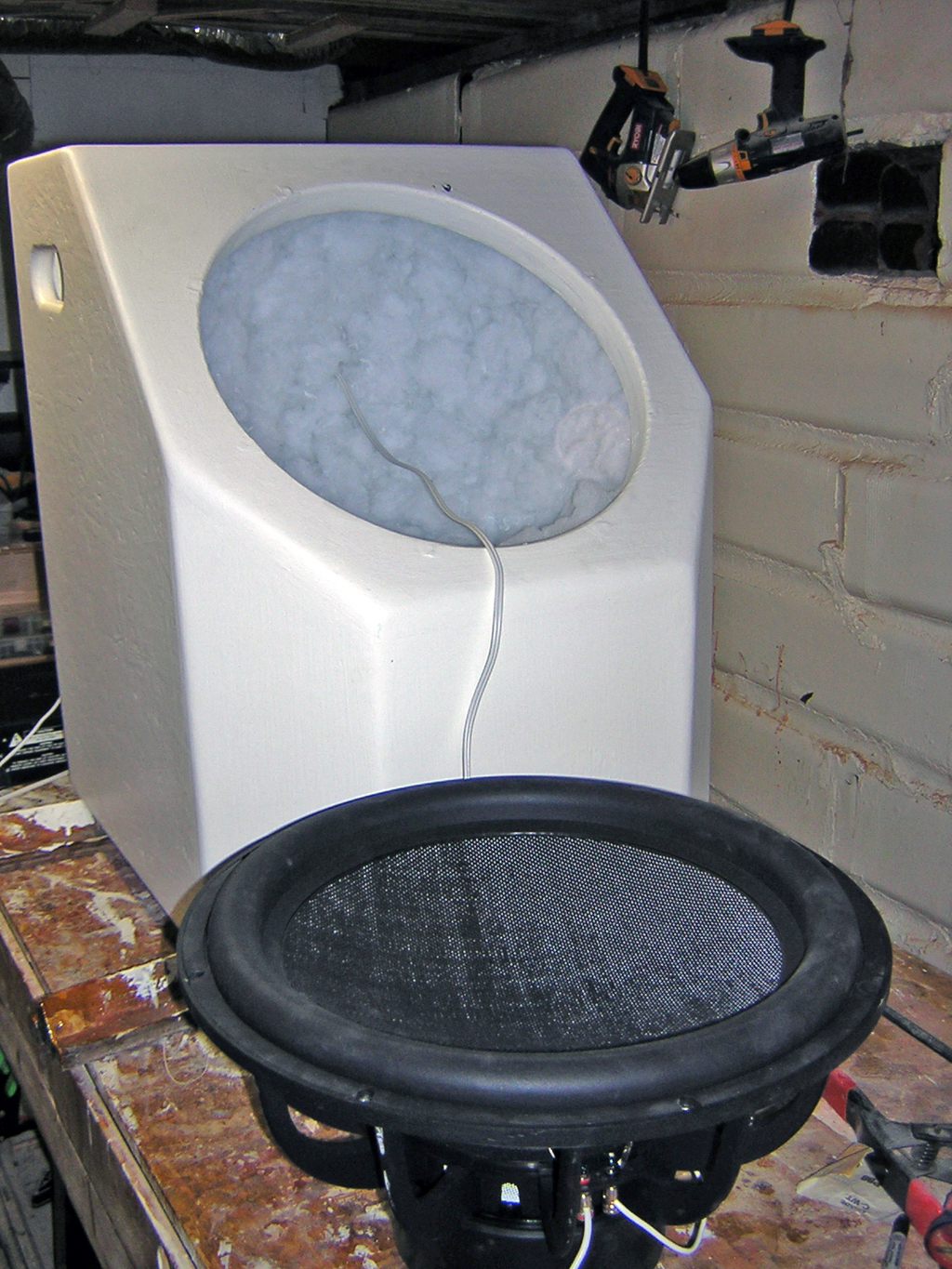
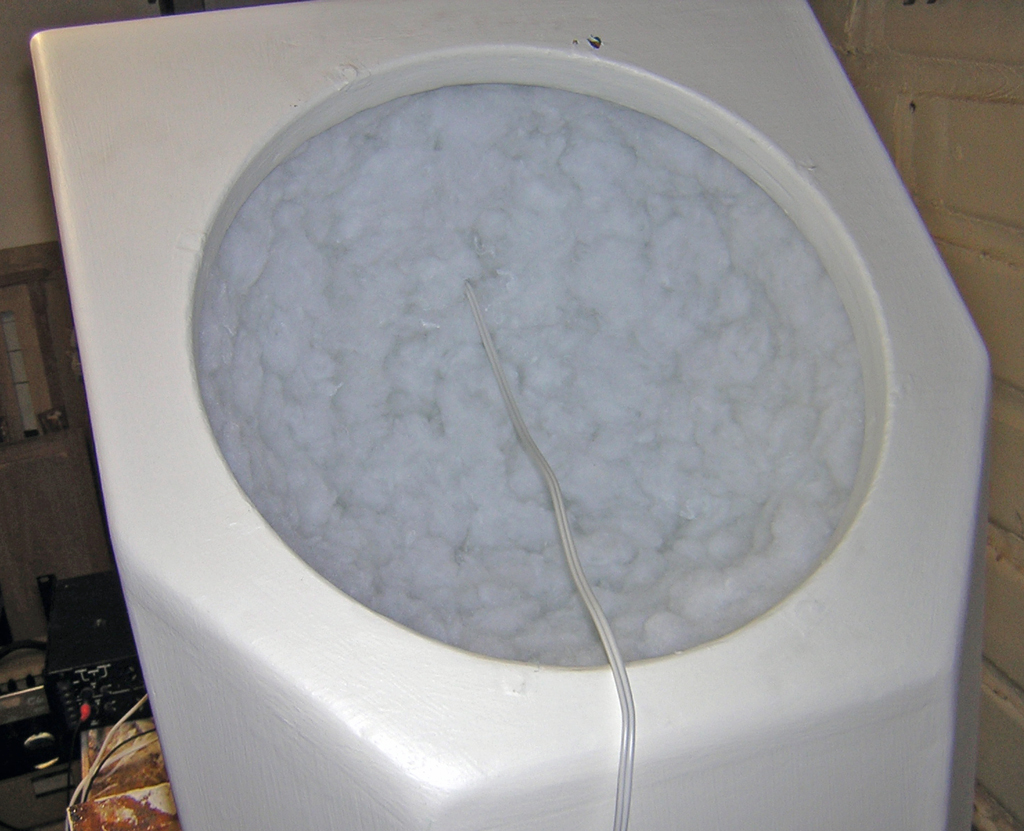
I have seen recommendations that sealed woofers should be damped with about 1 pound per cubic foot of polyester fiberfill. This speaker was damped with five pounds of fiberfill. Or maybe it was six pounds, can't recall. There was a 1 pound package and then a big box that contained either four or five pounds.
Fiberfill is an interesting material to work with, very light and fluffy. Fiberfill can be fluffed out with fingers and then it stays where you put it without settling or compression. If you take a big handful of the stuff, tear it into tiny little shreds with the fingers, then squeeze it back together into a lump-- Then the final lump looks much the same as the original lump before it was shredded into tiny pieces and squeezed back together.
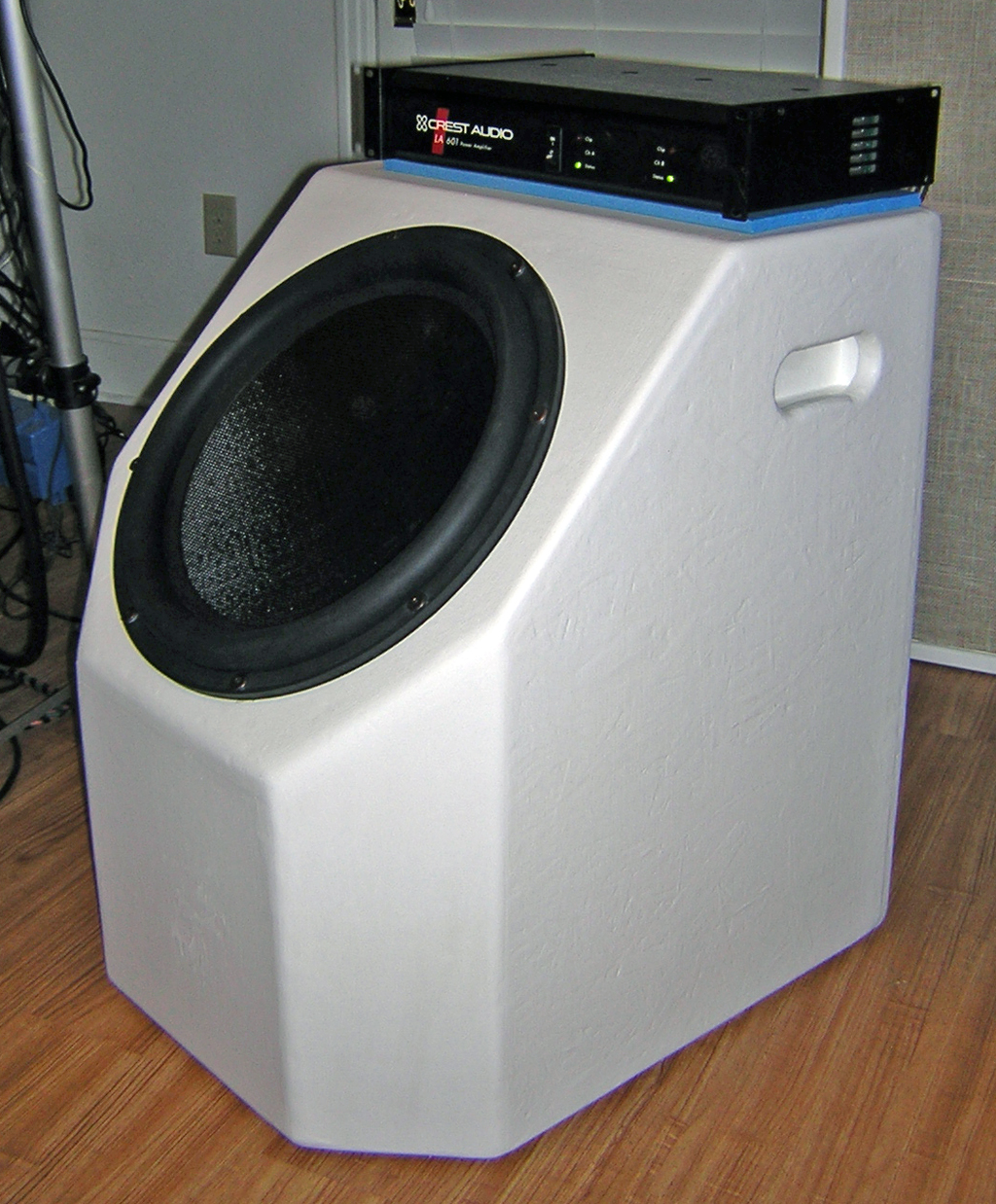
Here is the finished cabinet. Final testing before installation. The UM18-22 speaker is a moose. Heavy-duty frame with huge magnets. The nomex honeycomb woven-fiberglass-exterior cone is very strong-- Strong enough that I don't think protection is necessary in my usage environment. The speaker has such large excursion, that a proper speaker protection grille would need to sit far above the speaker to keep the cone from hitting the grille. The grille would need to be very stiff in order to avoid rattling when the woofer starts moving air. The rubber surround seems about as tough and thick as automobile tire inner tube material.
I glued several large pieces of furniture bumper felt on the bottom for feet. This slides very easily on a hard floor without damaging the floor. Which is a good thing, because the cabinet + speaker weighs in excess of 100 pounds and is very difficult for an old geezer to pick up.
The unloaded cabinet itself is fairly heavy, but relatively easy to tote short distances or re-orient during construction. It was fairly easy to get the empty cabinet off my workbench, onto a hand truck, and into my office. I final-mounted the speaker into the cabinet, with the cabinet sitting in the middle of the office floor. After that, the cab+speaker got very heavy indeed for the final trip for a couple of feet from the testing position to the installed position.

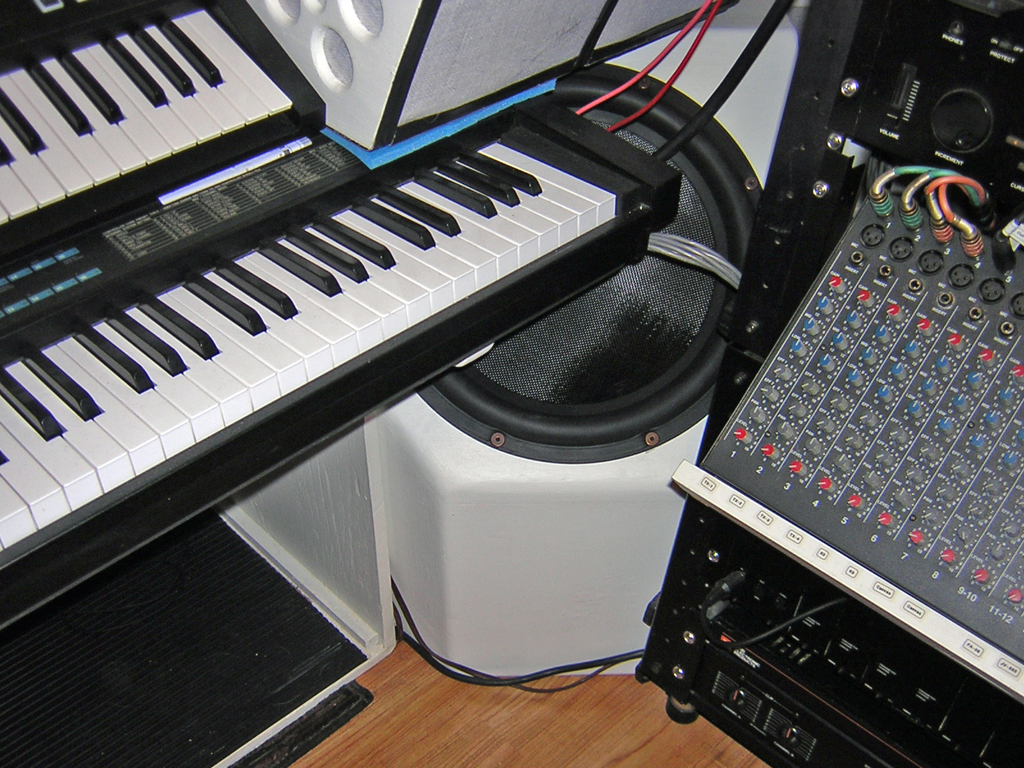
Here is the subwoofer cuddled up in its corner, at a 45 degree angle both vertical and horizontal.
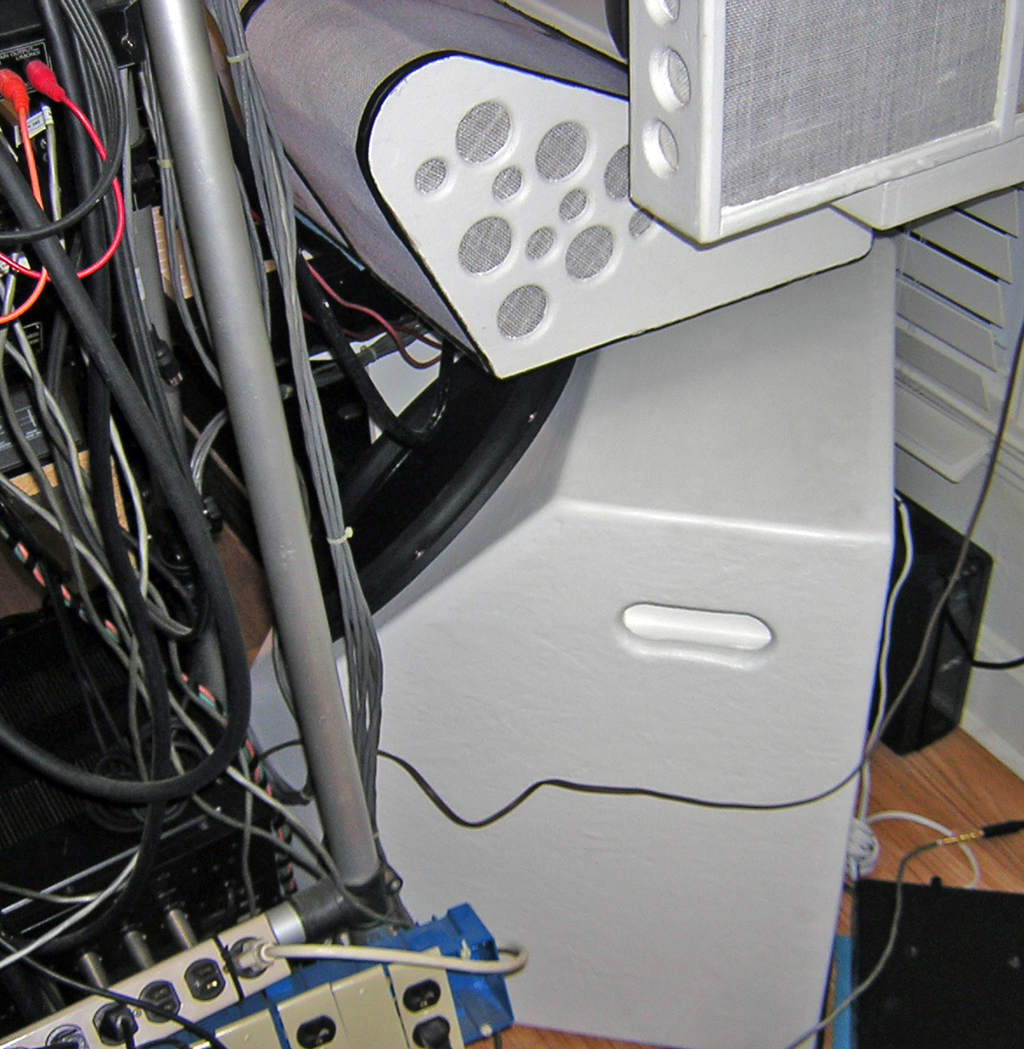
It is powered by an old crest power amp I had laying around, four ohms in bridge mode. In the ballpark of 400 or 500 watts max RMS. Which has no problem with loudness or dynamic range in the small office. Typical listening levels of 70 to 90 dB SPL, C weighted, at the listening position, though it will easily get much louder very clean-sounding.
The mains are old JBL 4208 monitors driven by an old JBL-Urie amp. The mains and subwoofer are driven by a DBX Driverack which works great.
I set up Room EQ Wizard software with the measurement mic at listening position. Put the software in real time analyzer mode, and did extensive tweaking of the Driverack crossover settings for several hours. Tested many crossover frequencies, at 6 dB, 12 dB, 18 dB and 24 dB crossover slopes. Symmetrical frequencies/slopes and also selected assymetrical frequencies/slopes. Both butterworth and linkwitz-riley crossover types.
There were many good settings, but in my room, the sweetest crossover settings appeared to be 24 dB linkwitz-riley. One sweet spot at 80 Hz and another sweet spot at 200 Hz. After much listening and testing, finally decided on the 80 Hz, 24 dB linkwitz-riley as the best performing crossover setting, in this room and at this specific speaker location in the room.
The JBL 4208 main monitors are -3 dB at 60 Hz, so a -6 dB cut at 80 Hz mostly avoids the non-flat lower response region of the mains. The mains are rear-ported, but because I don't need bass extension on the mains, they seem to work quite well with the rear ports blocked via rolled-up fat wool socks. It avoids some phase anomalies in the mid bass where the ports kick in, and seems to reduce interactions between the mains and front wall in the mid bass. It measures flatter in the mid bass, in combination with the subwoofer, if the mains ports are blocked.
I like it. Along with room treatment and other tweaks, the system sounds very balanced down to 20 Hz, and it measures “flat” down to about 25 Hz. I suspect that my small room is the limiting factor, rather than the speaker or cabinet.
It is fun to listen to commercial mixes. It is fun to play keyboards on this system. For instance, some synthesizer sub-bass patches, and most synthesizer acoustic bass patches, can “put the hurt on” typical pro-sound woofers or home systems. Most music speaker systems, at non-trivial sound levels-- Some low-bass patches tend to bottom-out the speaker or make the cabinet sound like it is trying to explode.
At non-painful levels in this small room, there is none of that bad behavior with this subwoofer. Provided the system is never cranked so loud that I blow out my ears, the subwoofer's capacity is “unlimited”. If that makes any sense. In other words, I can't make the speaker sound bad at non-painful volume levels.